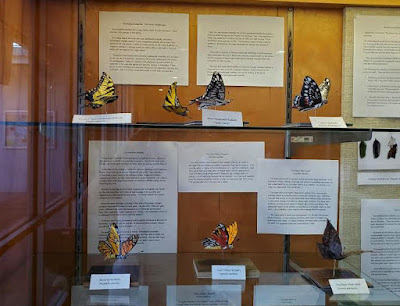"Pulelehua!"
"Gesundheit!"
In actuality, Pulelehua is not the noise made by a Samoan with hay fever, but rather the Hawaiian word for butterfly. On New Year's Eve 2019 my butterfly exhibit opened at the Kailua Kona library to rave reviews. Well, I planted the first of those reviews in the local paper, West Hawaii Today.
 |
| They let anybody into the library! |
Several people have remarked that initially they thought my paper mache models were actual mounted lepidopterans. How gratifying. With all due modesty, I think some of my models look better than actual butterflies. Perhaps if Pastor Brian puts in a word with the Creator, He will substitute one of our models for the current real thing.
In my interview with the newspaper, I said that there would be 15 models. When push came to shove, there were only 14, so on Sandra's advice I included an early attempt at a tiger swallowtail. If you attend the exhibit, perhaps you can pick it out. Hint: As I was just getting started I took the liberty of fusing the front and back wings, so that model has only two wings.
 |
| Swallowtails above, Monarch , Gulf Fritillary and the Black Witch below |
In addition to butterflies, the exhibit includes one moth, the black witch, a very common insect in Kailua. The black witch is so big that when seen in the evening it is sometimes confused with a small bat. The black witch comes with a number of legends. It is has been introduced from Central America, where the primitives believe that it is an evil spirit come to haunt them. Not to be outdone in the superstition department, the Hawaiians believe that it is a deceased relative returning for a friendly visit. The good news is that this relative never asks for money.
A big part of the exhibit covers the monarch butterfly. The monarch came to Hawaii after Captain Cook and the first batch of Yankee missionaries. Once white folks built houses in Hawaii, they needed shrubs. Hence the giant crown milkweed was introduced to grace the gardens of the new socioeconomic elite. As you should know, plants of the milkweed family are the obligate host of all
 |
| A Monarch caterpillar goes chrysalis! SKG 1/10/20 |
As I was preparing for the exhibit I had a meeting with Denise, our just a little dishy head librarian. Denise took me out back behind the library and showed me the GCM that grows there. We met Chris, the gardener and admired the monarchs flying through the leaves, whose leaves reach at least fifteen feet towards the heavens. Praise the Lord. Today, before the library opened, Sandra (who is more than just a little dishy) and I went out back. Chris was there again. My sharp eyed honey found two chrysalises and then Chris found a caterpillar that was in the process of going chrysalis.
Butterflies only live three to four weeks. During that time they have sex and undergo internal fertilization. Interestingly, most, but not all, arthropods undergo internal fertilization and lay fertilized eggs. That should give you something to think about the next time you are in the back room at the video rental parlor. To say the least, the number of arthropod species, including crustaceans, insects, centipedes and arachnids is off the chart; there are nearly one million species of arthropods. To use a polite phrase, that is a whole lot of "internally fertilizing" bugs.
Anyway, butterflies and moths lay eggs on the leaves of the host plant, the only leaves their caterpillars are capable of eating. Which upon hatching they proceed to do. Voraciously. After a week or so of eating a caterpillar cements its derriere to a branch (or some other handy solid structure) weaves a
 |
| Vanessa Butterflies, Painted Lady, Red Admiral and Kamehameha |
Moths form a cocoon woven from silk. Hence the silkworm!
The other emphasis of the exhibit is the Kamehameha butterfly and its relatives that have been introduced to Hawaii. Its amazing to think that millions of years ago a genus Vanessa butterfly or two made it across the ocean and were the Adam and Eve of our only big beautiful butterfly. You can refer to an earlier blog in which the Redoubtable SKG and I successfully sought this butterfly in Hawaii Volcanoes National Park. The caterpillar of this butterfly only eats mamane, the Hawaiian nettle. Luckily, mamane is cultivated for tea. One has to contemplate the dilemma faced by a tea farmer as he watches his crop falling prey to Kamehameha caterpillars. This may be hypothetical or it may be an advertisement for Sevin.
 |
| The monarch butterfly says, "See you at the library!" |
jeff
All the pictures in this blog were taken by the Redoubtable SKG. The gorgeous banner was produced by our amazing library technician Lee, who like my sweetie wants less web presence, not more. But if you go in the library and you see a sweet young thing at the desk with a sticker that says, "Hi! I'm Lee." that's her. And none of this would have been possible without the guidance of Dr. Daniel Rubinoff, UH Manoa and Dr Patrick Hart in Hilo. Thanks to one and all.

Your display is wonderful, wish we were in Kona at this time to see it. Really glad you shared it here in your blog.
ReplyDeleteLoverly
ReplyDelete